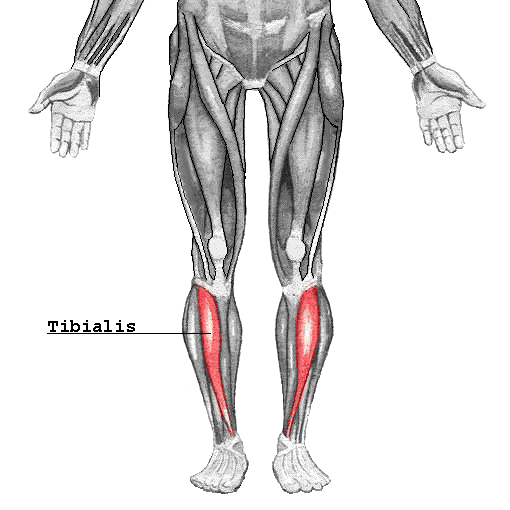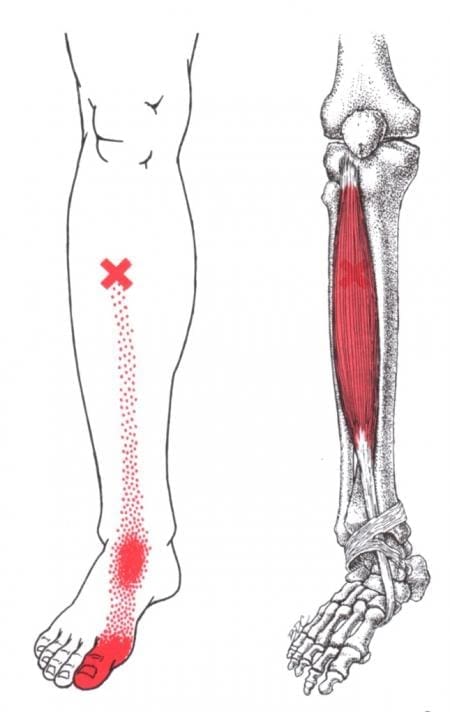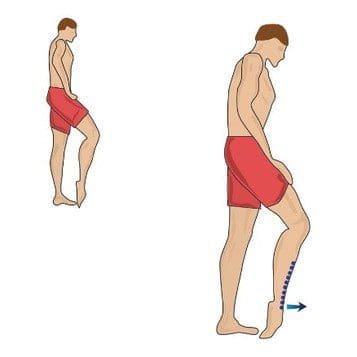Table of Contents
Introduction
The legs are crucial for many individuals to move, jump, run, walk, and stand in various locations. The legs involve the thighs, hips, and knees as they work together to provide support and a range of movements for the body. For athletes, the legs allow them to run from one obstacle to another and kick the object to finish the game they are participating. Many individuals require strong leg muscles to keep the body balanced and stabilized from the upper body’s weight. One leg muscle that allows the body to be stabilized is the anterior tibialis muscle. When the legs suffer from various sports injuries or injuries in general, it can lead to issues like shin splints correlated with trigger points that can cause pain to the lower portion of the legs and can affect the body’s stability. Today’s article examines the anterior tibialis muscles, how shin splints are associated with myofascial trigger points, and various methods to treat shin splints. We refer patients to certified providers that incorporate various techniques in the lower body extremities, like lower leg pain therapies correlating to myofascial trigger point pain, to aid many people dealing with pain symptoms along the anterior tibialis muscles, causing shin splints. We encourage and appreciate each patient by referring them to associated medical providers based on their diagnosis, especially when appropriate. We understand that education is an excellent source to asking our providers intricated questions at the patient’s request. Dr. Alex Jimenez, D.C., only utilizes this information as an educational service. Disclaimer
What Is The Tibialis Anterior Muscles?

Have you been dealing with leg pain affecting your ability to move? Do you feel radiating pain going down to your feet? Or does even the smallest amount of pressure sends shooting pain from your knees to your feet? Many of these leg pain issues correlate to myofascial trigger points along the anterior tibialis muscles, mimicking shin splints. Studies reveal that the leg is divided into anterior, lateral, and posterior crural compartments. As one of the largest four muscles in the anterior compartment of the legs, the tibialis anterior is a thick muscle located in the front of the lateral tibia of the legs. The tibialis anterior has the muscle that allows the function to the lower leg and tendons that travel down to the ankle and foot. The anterior tibial muscle plays an important role in the lower leg through dorsiflexion and inversion of the foot. To that point, the anterior tibial muscle plays a key role in energy absorption when walking and maintaining balance.
Shin Splints Associated With Myofascial Trigger Points
Since the anterior tibial muscle plays a key role in energy absorption when it comes to walking and maintaining balance in the body, when the lower leg extremity muscles have been overused, it causes stress on the tibial anterior. It can lead to medial tibial stress syndrome or shin splints. Studies reveal that shin splints affect many athletes, especially runners, by causing pain and discomfort to the tibial anterior. This can cause mobility and balancing issues in the legs and lead to the development of myofascial trigger points in the anterior tibial muscle. Now, how do shin splints and myofascial trigger points correlate with each other?

Dr. Janet G. Travell, M.D., author of “Myofascial Pain and Discomfort: The Trigger Point Manual,” mentioned that one of the chief complaints many people have when experiencing myofascial trigger points would feel muscle weakness of dorsiflexion to the foot when walking. Other complaints include:
- Falling
- Dragging their feet
- Ankle weakness
The book also mentioned that myofascial pain causes referred pain to the anterior tibial muscle, thus mimicking shin splints. The activation from myofascial trigger points causes an overload of the anterior tibial muscle, thus causing various pain issues in the legs and restricting mobility to the muscle itself.
An Overview Of Tibialis Anterior Trigger Points- Video
Have you been dealing with radiating pain from your knees to your feet? Do your legs feel heavy from walking a short distance? Or do your leg muscles feel cramps that hinder your ability to move? These pain-like issues are associated with the anterior tibialis muscle being affected by trigger points. Trigger points or myofascial pain syndrome can affect the worldwide population by affecting a muscle or muscle group in the body that can impair mobility, cause pain-like symptoms, and reduces a person’s overall sense of well-being. Trigger points along the tibialis anterior muscle cause mobility issues and mimic shin splint issues in the legs. All is not lost, however, as there are ways to reduce pain-like symptoms and help manage myofascial trigger points in the anterior tibialis muscle. The video above explains where the trigger points are located in the tibialis anterior through palpitation. By finding the trigger points in the affected muscle, doctors can refer patients to pain specialists who target trigger points and provide treatment to reduce the pain.
Various Methods Of Treating Shin Splints

There are various methods to treat the tibialis anterior when treating shin splints associated with trigger points. Studies reveal that one of the multiple ways to reduce shin splints is to strengthen the core hip muscles, improve running mechanics, and prevent lower-extremity overuse injuries. Muscle strength training allows the other muscles from the abdominals, gluteal, and hips to be stronger and reduce strain on the anterior tibialis muscles. Another method that many individuals should consider is to wear the appropriate footwear. Wearing the proper footwear can reduce the shock absorption to the feet and reduce the overloading forces on the anterior tibialis. These are two methods to manage trigger points and prevent shin splints from re-occurring in the legs.
Conclusion
As one of the four leg muscles, the anterior tibialis is a large muscle located in front of the lateral tibia and travels down to the ankles and foot. This muscle plays an important role in the legs as it allows dorsiflexion and inversion of the foot while also playing a key role in energy absorption when walking and maintaining balance. When the anterior tibialis becomes overused, it can develop trigger points, which invoke shin splints in the legs. When the legs suffer from shin splints associated with trigger points, it can cause pain in the lower leg extremities and cause the body to become unstable. However, various methods can take the load off the tibialis anterior and help improve the body’s stability, allowing the individual to walk without feeling pain traveling up from their feet.
References
Deshmukh, Nikita S, and Pratik Phansopkar. “Medial Tibial Stress Syndrome: A Review Article.” Cureus, U.S. National Library of Medicine, 7 July 2022, https://www.ncbi.nlm.nih.gov/pmc/articles/PMC9356648/.
Galbraith, R Michael, and Mark E Lavallee. “Medial Tibial Stress Syndrome: Conservative Treatment Options.” Current Reviews in Musculoskeletal Medicine, U.S. National Library of Medicine, 7 Oct. 2009, https://www.ncbi.nlm.nih.gov/pmc/articles/PMC2848339/.
Juneja, Pallavi, and John B Hubbard. “Anatomy, Bony Pelvis and Lower Limb, Tibialis Anterior Muscles.” In: StatPearls [Internet]. Treasure Island (FL), StatPearls Publishing, 29 Aug. 2022, https://www.ncbi.nlm.nih.gov/books/NBK513304/.
Travell, J. G., et al. Myofascial Pain and Dysfunction: The Trigger Point Manual: Vol. 2:the Lower Extremities. Williams & Wilkins, 1999.
Zielinska, Nicol, et al. “Anatomical Variations of the Tibialis Anterior Tendon Insertion: An Updated and Comprehensive Review.” Journal of Clinical Medicine, U.S. National Library of Medicine, 19 Aug. 2021, https://www.ncbi.nlm.nih.gov/pmc/articles/PMC8396864/.
Disclaimer
Post Disclaimer
Professional Scope of Practice *
The information on this blog site is not intended to replace a one-on-one relationship with a qualified healthcare professional or licensed physician and is not medical advice. We encourage you to make healthcare decisions based on your research and partnership with a qualified healthcare professional.
Blog Information & Scope Discussions
Welcome to El Paso's Premier Wellness and Injury Care Clinic & Wellness Blog, where Dr. Alex Jimenez, DC, FNP-C, a board-certified Family Practice Nurse Practitioner (FNP-BC) and Chiropractor (DC), presents insights on how our team is dedicated to holistic healing and personalized care. Our practice aligns with evidence-based treatment protocols inspired by integrative medicine principles, similar to those found on this site and our family practice-based chiromed.com site, focusing on restoring health naturally for patients of all ages.
Our areas of chiropractic practice include Wellness & Nutrition, Chronic Pain, Personal Injury, Auto Accident Care, Work Injuries, Back Injury, Low Back Pain, Neck Pain, Migraine Headaches, Sports Injuries, Severe Sciatica, Scoliosis, Complex Herniated Discs, Fibromyalgia, Chronic Pain, Complex Injuries, Stress Management, Functional Medicine Treatments, and in-scope care protocols.
Our information scope is limited to chiropractic, musculoskeletal, physical medicine, wellness, contributing etiological viscerosomatic disturbances within clinical presentations, associated somato-visceral reflex clinical dynamics, subluxation complexes, sensitive health issues, and functional medicine articles, topics, and discussions.
We provide and present clinical collaboration with specialists from various disciplines. Each specialist is governed by their professional scope of practice and their jurisdiction of licensure. We use functional health & wellness protocols to treat and support care for the injuries or disorders of the musculoskeletal system.
Our videos, posts, topics, subjects, and insights cover clinical matters and issues that relate to and directly or indirectly support our clinical scope of practice.*
Our office has made a reasonable effort to provide supportive citations and has identified relevant research studies that support our posts. We provide copies of supporting research studies available to regulatory boards and the public upon request.
We understand that we cover matters that require an additional explanation of how they may assist in a particular care plan or treatment protocol; therefore, to discuss the subject matter above further, please feel free to ask Dr. Alex Jimenez, DC, APRN, FNP-BC, or contact us at 915-850-0900.
We are here to help you and your family.
Blessings
Dr. Alex Jimenez DC, MSACP, APRN, FNP-BC*, CCST, IFMCP, CFMP, ATN
email: coach@elpasofunctionalmedicine.com
Licensed as a Doctor of Chiropractic (DC) in Texas & New Mexico*
Texas DC License # TX5807
New Mexico DC License # NM-DC2182
Licensed as a Registered Nurse (RN*) in Texas & Multistate
Texas RN License # 1191402
ANCC FNP-BC: Board Certified Nurse Practitioner*
Compact Status: Multi-State License: Authorized to Practice in 40 States*
Graduate with Honors: ICHS: MSN-FNP (Family Nurse Practitioner Program)
Degree Granted. Master's in Family Practice MSN Diploma (Cum Laude)
Dr. Alex Jimenez, DC, APRN, FNP-BC*, CFMP, IFMCP, ATN, CCST
My Digital Business Card


